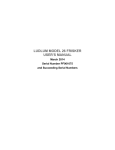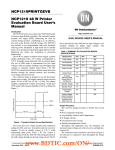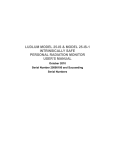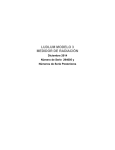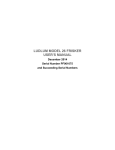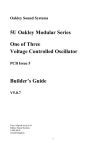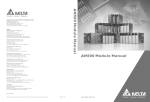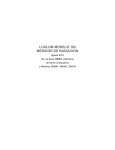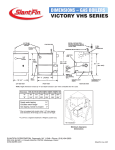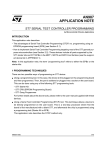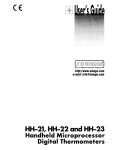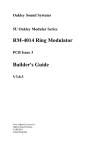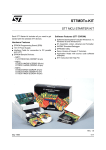Download LUDLUM ION CHAMBER MODEL 9-4 USERS MANUAL May 2013
Transcript
LUDLUM ION CHAMBER MODEL 9-4 USERS MANUAL May 2013 Serial Number 265751 and Succeeding Serial Numbers LUDLUM ION CHAMBER MODEL 9-4 USERS MANUAL May 2013 Serial Number 265751 and Succeeding Serial Numbers Ludlum Measurements, Inc. Copyright© 2013. Safety Precautions In the interest of safety, this manual contains many notes, cautions, and warnings that the user should follow to protect both the user and the instrument from harm. Warning – The operator or responsible body is warned that failure to follow the specified operating, handling, or maintenance procedures may result in death, serious injury, or a longterm health hazard. Caution - The operator or responsible body is cautioned that the protection provided by the equipment may be impaired if the equipment is used or handled in a manner not specified by Ludlum Measurements, Inc. Note – The operator or responsible body should give special attention to the information provided, as failure to do so may result in damage to the instrument or instrument failure. GENERAL SAFETY PRECAUTIONS The following general safety precautions apply to the operator of the instrument during all phases of operation. These precautions should be followed or else the instrument may no longer provide the necessary protection for which the instrument was intended. DO NOT REMOVE CHASSIS FROM CAN WITH BATTERIES INSTALLED Normal operation of the instrument should always be performed with the instrument chassis attached to a can. The operator is strongly cautioned to take the following precautions to avoid contact with internal hazardous live parts should it be determined that the chassis needs to be separated from the can: 1. Turn the instrument power off and remove the batteries. 2. Allow the instrument to sit for one minute before accessing internal components. Ludlum Measurements, Inc. i May 2013 DO NOT SUBMERGE IN WATER The instrument meets the standards as specified by ANSI N42.17C for moisture exposure; however, the instrument is not waterproof and should never be submersed in water. WARNINGS APPLICABLE TO HAZARDOUS MATERIALS Visual images are used in this manual to convey the possible hazard associated with the operation, handling, or maintenance of the instrument. The following definitions are provided to describe these hazards; however, Ludlum Measurements cannot make any guarantees to the extent of the hazard posed. CHEMICAL – this is an indication that handling the material may cause burns or irritation to the skin. ELECTRICAL SHOCK – unless the necessary precautions are taken, this is an indication that physical contact with the internal components of the instrument may result in electrical shock. HOT hot AREA – this is an indication that the component or components may be resulting in burns to the skin. POISON – this is an indication that the contents may be hazardous to your health if consumed. INSTRUMENT MARKINGS The Model 9-4 Ion Chamber is marked with the following symbols: Crossed-out wheelie bin – this symbol notifies the consumer that the product is not to be mixed with unsorted municipal waste when discarding; each material must be separated. The symbol is placed on the battery compartment lid. The “CE” mark is used to identify this instrument as being acceptable for use within the European Union. Ludlum Measurements, Inc. ii May 2013 TABLE OF CONTENTS INTRODUCTION ................................................................................................................................................... 1 IDENTIFICATION OF CONTROLS AND FUNCTIONS ................................................................................................. 2 GETTING STARTED ............................................................................................................................................... 3 UNPACKING AND REPACKING .................................................................................................................................. 3 INSTRUMENT CONFIGURATION ................................................................................................................................. 3 BATTERY INSTALLATION ......................................................................................................................................... 4 BATTERY TEST ...................................................................................................................................................... 5 OPERATIONAL CHECK ............................................................................................................................................. 5 TECHNICAL THEORY OF OPERATION ..................................................................................................................... 7 CHAMBER .............................................................................................................................................................. 7 CHAMBER WINDOW ................................................................................................................................................. 7 ELECTROMETER ..................................................................................................................................................... 7 RANGE CHANGE ..................................................................................................................................................... 8 RESET ................................................................................................................................................................... 8 OFFSET ADJUSTMENT ............................................................................................................................................. 8 ZERO ADJUST ........................................................................................................................................................ 8 RANGE CALIBRATION .............................................................................................................................................. 9 RANGE CHANGING .................................................................................................................................................. 9 POWER SUPPLIES ................................................................................................................................................. 10 CLEANING AND MAINTENANCE .......................................................................................................................... 11 PRECAUTIONS ...................................................................................................................................................... 11 MAINTENANCE ..................................................................................................................................................... 11 Recalibration ........................................................................................................................................................ 11 Storage .................................................................................................................................................................. 12 Desiccant .............................................................................................................................................................. 12 SPECIFICATIONS ................................................................................................................................................. 14 RECYCLING ......................................................................................................................................................... 17 PARTS LIST ......................................................................................................................................................... 18 MAIN CIRCUIT BOARD, DRAWING 293 X 711........................................................................................................... 19 ELECTROMETER BOARD, DRAWING 293 X 670 ........................................................................................................ 22 DRAWINGS ........................................................................................................................................................ 23 TABLE OF FIGURES Figure 1 - Battery Installation and Removal ...............................................................................................................................................................................................4 Figure 2 - Battery Door Internal Markings .................................................................................................................................................................................................5 Figure 3 - Main Board Layout (Front) ............................................................................................................................................................................... Back of manual Figure 4 - Main Board Layout (Back) ................................................................................................................................................................................ Back of manual Figure 5 - Main Board Schematic (Page 1) ........................................................................................................................................................................ Back of manual Figure 6 - Main Board Schematic (Page 2) ........................................................................................................................................................................ Back of manual Figure 7 - Main Board Schematic (Page 3) ........................................................................................................................................................................ Back of manual Figure 8 - Main Board Schematic (Page 4) ........................................................................................................................................................................ Back of manual Figure 9 - Electrometer Board Layout (Front) ................................................................................................................................................................. Back of manaul Figure 10 - Electrometer Board Schematic (Page 1) ....................................................................................................................................................... Back of manual Ludlum Measurements, Inc. iii May 2013 MODEL 9-4 1 Technical Manual Section 1 Section Introduction T he Ludlum Model 9-4 is a five-range ion chamber instrument for measuring beta-gamma radiation up to 50 R/hr. The chamber wall, including the instrument case, is 1000 mg/cm². A 1000 mg/cm² retractable beta shield allows beta measurement with a 7 mg/cm² window. The six-position selector switch selects OFF, ×10K, ×1K, ×100, ×10, and ×1 multipliers. The standard meter face has a dial from 0 to 5 mR/hr. Other features include a LIGHT toggle switch to activate the white LED display light, a RESET pushbutton, and a ZERO ADJUST knob. All calibration controls are done digitally using a special calibration kit (part number: 4293676) available from Ludlum Measurements. This kit includes a special instrument can, pressure calibration kit, all necessary cables, and control software. The Model 9-4 calibration kit allows the ability to calibrate for temperature and pressure. Temperature and pressure compensation thus allows the instrument to measure within 20% of the true value even when the temperature is varied from -20 to 50 °C (-4 to 122 °F), and within 15%, as the pressure is varied from 70 kPa to 106 kPa. The unit is powered by two “D” cell batteries. A fresh set of alkaline batteries should last more than 400 hours. An internal shunt may be positioned so that the detector wall voltage is maintained even when the unit is OFF. Doing so reduces the normal fifteen-minute, cold-start delay. Ludlum Measurements, Inc. Page 1 May 2013 MODEL 9-4 2 Technical Manual Section 2 Section Identification of Controls and Functions Range Selector Switch: This is a six-position switch marked OFF, ×10K, ×1K, ×100, ×10, and ×1. Turning the range selector switch from OFF to one of the range multiplier positions (×10K, ×1K, ×100, ×10, and ×1) provides the operator with an overall range of 0 to 50,000 mR/hr. Multiply the scale reading by the multiplier to determine the actual scale reading. BAT TEST: Press this switch to check the battery. The meter should read within the BAT TEST scale on the meter. The range switch may be in any position except OFF for the battery test. LIGHT ON-OFF Toggle Switch: In the ON position this switch energizes the white LED display lights located in the meter compartment. ZERO ADJUST: This is a full one-turn control that allows for compensation of electrometer drift. Press and hold the RESET button for five seconds, then adjust for a zero reading. RESET Button: The RESET circuit grounds the chamber and opens the chamber connection to the electrometer. This action causes a hard upscale transient on the ×1 and ×10 scales. Hold the RESET down for five seconds to allow the transient to decay. When the RESET switch is released, the chamber is reconnected to the electrometer, and a hard downscale transient will occur. Allow five more seconds for recovery. Beta Shield (on bottom): This retractable shield allows exposure to beta radiation with a window thickness of 7 mg/cm². With the slide closed, the window is 1000 mg/cm². Depress the button on the side of the slide assembly to release the slide. Release the button to hold the slide open or closed. Ludlum Measurements, Inc. Page 2 May 2013 MODEL 9-4 3 Technical Manual Section 3 Section Getting Started Unpacking and Repacking Remove the calibration certificate and place it in a secure location. Remove the instrument and all accessories and ensure that all items on the packing list are in the carton. To return an instrument for calibration or repair, provide sufficient packing material to prevent damage during shipment and affix appropriate warning labels to promote careful handling. The following items and information should also be included to ensure quick turnaround time of your equipment: instrument and related cable(s) brief description as to the reason for return description of service requested return shipping address customer name and telephone number Instrument Configuration The Model 9-4 has two options for chamber wall voltage. An internal jumper may be selected to maintain voltage on the chamber wall with the instrument turned off. This option allows a faster, three-minute settling time when the instrument is frequently used. If the instrument is infrequently used, it is recommended that this option not be used because of battery drain. The instrument is shipped with the chamber wall voltage maintained when the instrument is turned off. Ludlum Measurements, Inc. Page 3 May 2013 MODEL 9-4 Technical Manual Section 3 With the continuous wall voltage on and instrument off, battery life is approximately six months. Without this option, the battery drain is zero with the instrument OFF; however, a settling time of 15 minutes is required for the ×1 scale to settle within 0.1 mR/hr. Battery Installation Ensure the Model 9-4 range selector switch is in the OFF position. Open the battery lid by pushing down and turning the quarter-turn thumbscrew counterclockwise a quarter of a turn. Install two “D” size batteries in the compartment. Figure 1 - Battery Installation and Removal Ludlum Measurements, Inc. Page 4 May 2013 MODEL 9-4 Technical Manual Section 3 Figure 2 - Battery Door Internal Markings Note the (+) and (-) marks inside the battery holder (see Figure 2 - Battery Door Internal Markings). Match the battery polarity to these marks. Insert both batteries to match these marks. Close the battery box lid, then push down and turn the quarter-turn thumb screw clockwise a quarter of a turn. The center post of a battery is positive. The batteries are placed in the battery compartment in opposite directions. Battery Test The batteries should be checked each time the instrument is turned on. This is accomplished simply by pressing the BAT TEST button. Ensure that the meter needle deflects to the battery test portion of the meter scale. If the meter does not respond, check to see if the batteries have been correctly installed. Replace the batteries if necessary. Operational Check To assure proper operation of the instrument between calibrations and periods of non-use, the following instrument operational check should be performed prior to use. A reference reading with a check source should be obtained at the time of initial calibration or as soon as possible for use in confirming proper instrument operation. In each case, ensure a proper reading on each scale. If the instrument fails to read within 20% of a proper reading, it should be sent to a calibration facility for recalibration. Ludlum Measurements, Inc. Page 5 May 2013 MODEL 9-4 Technical Manual Section 3 Turn the instrument range switch to the ×1 position. As the selector switch moves from the ×100 to ×10 a meter transient will occur. This transient is caused by an internal range relay and is normal. Allow time for the ×1 scale to stabilize. Press and hold the RESET button. Adjust the ZERO ADJUST knob until a meter reading of zero is obtained. Release the RESET button. The RESET circuit grounds the chamber and opens the chamber connection to the electrometer. This would normally cause a transient on the ×1 or ×10 scale. The meter needle will, on these two ranges, display a “countdown” from five to zero when the RESET is pressed, and also when it is released. On these two lower ranges the user should hold the RESET down for five seconds to allow the transient to decay. Expose the instrument to a check source. Observe that the meter reading increases as the check source gets closer to the instrument. The depressions on the side of the instrument housing indicate the center of the chamber. Open the beta shield and expose the check source to the center of the chamber window. The instrument reading should be within 20% of the check source reference after settling time. Damage to the metallized polyester window on the back side of the instrument may result when the slide is open if careful instrument handling is not practiced. The window is fragile and may be punctured quite easily. Ludlum Measurements, Inc. Page 6 May 2013 MODEL 9-4 4 Technical Manual Section 4 Section Technical Theory of Operation Chamber The chamber housing is constructed from acrylic and is coated inside and outside with carbon. The internal wall is maintained at approximately -90 volts. The external wall is at guard potential (approximately 1.5 volts). The electrode is connected to the electrometer input and is maintained at guard potential by the electrometer. Chamber Window The chamber window consists of three parts. The beta shield is 1000 mg/cm² phenolic. One layer of 3.5 mg/cm² aluminized metallized polyester is glued to the bottom of the can. One layer of 3.5 mg/cm² aluminized metallized polyester covers the ion chamber, resulting in a window thickness of 7 mg/cm² with the beta slide open and a 1000 mg/cm2 window with the beta slide closed. Electrometer The electrometer consists of U1, R2, and supporting components. On the ×1 scale, RL1 and RL2 are open. With conduction in the chamber to the negative wall, pin 8 of U1 goes slightly negative causing pin 4 of U1 to go positive, drawing current through R2, holding pin 8 of U1 near the guard voltage (+1.5 volts). With the chamber exposed to a 5 mR/hr field, the chamber current will be approximately 70 fA (70 x 10-15 amps) and electrometer output voltage will be 35 mV (0.035 V) relative to the guard voltage. At 50 mR/hr on the x10 range, the output voltage will be 350 mV (0.35 V) relative to the guard voltage. Ludlum Measurements, Inc. Page 7 May 2013 MODEL 9-4 Technical Manual Section 4 Range Change When the instrument is switched to the ×100, ×1K, or ×10K range, RL1 is closed, reducing the feedback resistance to approximately 4.2 x 109 ohms. At 500 mR/hr on the x100 range, the chamber current will be approximately 7 pA (7 x 10-12 amps) and the voltage out at pin 6 of U1 will be approximately 30 mV (0.03 V). Full-scale voltage outputs relative to the guard voltage for the x1K and x10K are 300 mV (0.3 V) and 3 V respectively. Reset Relay RL2 allows the chamber to be shorted to guard and the electrometer to be isolated for input bias current compensation. Offset Adjustment The electrometer op amp will have some offset voltage. Internal calibration control R111 will provide an offset voltage that can be adjusted to null out the electrometer offset voltage. Place instrument in a field less than 0.1 mR/hr, then select the ×100 scale and adjust R111 for zero meter reading. Zero Adjust The primary function of the zero adjust is to control input bias current in the electrometer. With the RESET (SW1) closed, the reset relay (RL2) opens the electrometer input and shorts the chamber output to guard. With the RESET held closed, input bias current is adjusted with the zero control for a zero meter dial reading. Allow a five-second recovery period for the meter to settle before and after using the RESET button on the ×1 and ×10 scales. Ludlum Measurements, Inc. Page 8 May 2013 MODEL 9-4 Technical Manual Section 4 Range Calibration Full-scale voltage for the electrometer output, pin 4 of U1 (electrometer board 5293-711) is approximately +0.03 volts for the ×1 range; 0.3 volts for the ×10 range; +0.03 volts for the ×100; and +0.3 volts for the ×1K range. The ×10K range will be somewhat lower than +3 volts due to nonlinear collection. On the ×1 scale, the electrometer voltage is coupled through the analog switch U102A to a series of op amps. U101 provides gain. U100 provides gain and reduces the output and reference from guard voltage to 0.2 volts. Voltage output at pin 1, U100 is approximately 2 volts at full scale. Higher scales follow the same scheme through the analog switches selected by the range switch. The output voltage of U100 is connected to microprocessor U110 which allows calibration, temperature correction, and altitude compensation. The signal reference voltage is 0.2 volts at the output of DA converter U112, allowing a below-zero meter reading when adjusting the zero control. Range Changing The microprocessor U110 detects the selected range and then selects the appropriate analog switch (U102A, U102B, or U103A) for the signal. A calibration constant is then provided by the microprocessor for each range. In the special case of ×10K scale, the microprocessor also provides a linearity correction. Each range may be calibrated by a calibration equipment kit when connected to P102. Ludlum Measurements, Inc. Page 9 May 2013 MODEL 9-4 Technical Manual Section 4 Power Supplies Six voltages are provided for instrument operation. U108 and associated components generate -90 volts for chamber wall voltage. The supply will run continually with the instrument off if the jumper is placed between pins 1 and 2 of JP100. If the operator chooses to have wall voltage off with the instrument switched off, then the jumper should be moved to pins 2 and 3 of JP100. U105 and associated components generate +5 volts for the main board circuits. U106 provides regulated +2.5 volt reference. VR100 provides +4.85 volts for the electrometer. U107 and associated components provides 1.5 volt guard voltage for the electrometer. U104 provides meter reference of 0.2 volts. Ludlum Measurements, Inc. Page 10 May 2013 MODEL 9-4 5 Technical Manual Section 5 Section Cleaning and Maintenance Precautions Instrument maintenance consists of keeping the instrument clean and periodically checking the batteries, desiccants, and calibration. The Model 9-4 (excluding chamber window) may be cleaned externally with a damp cloth, using only water as the wetting agent. Do not immerse the instrument in any liquid. Observe the following precautions when cleaning or performing maintenance on the instrument: 1. Turn the instrument OFF and remove the batteries. 2. Allow the instrument to sit for one minute before cleaning the exterior or accessing any internal components for maintenance. Accessing internal components for maintenance increases the risk of electrical shock if these steps are not followed. Maintenance RECALIBRATION Recalibration should be accomplished after maintenance or adjustments have been performed on the instrument. Recalibration is not normally required following instrument cleaning, desiccant servicing, or battery replacement. Ludlum Measurements, Inc. recommends recalibration at intervals no greater than one year. Check the appropriate regulations to determine required recalibration intervals. Ludlum Measurements, Inc. Page 11 May 2013 MODEL 9-4 Technical Manual Section 5 Ludlum Measurements offers a full-service repair and calibration department. We not only repair and calibrate our own instruments, but also most other manufacturers’ instruments. Calibration procedures are available upon request for customers who choose to calibrate their own instruments. STORAGE The batteries may be removed any time the instrument is placed into storage. Battery leakage may cause corrosion on the battery contacts, which must be scraped off and/or washed using a paste solution made from baking soda and water. Although this instrument will operate at very high ambient temperatures, battery seal failure may occur at temperatures as low as 37 °C (100 °F). Should battery seal failure occur, it may result in corrosion on the battery contacts. DESICCANT Remove the instrument can and observe the translucent plastic desiccant box. If the desiccant is blue, close the can and use the instrument. If the desiccant is pink, replace with a fresh box. The restraining strap may be loosened by pressing the center tab toward the strap. The silica used in the desiccant box may cause irritation to the skin if handled directly. Please take the necessary precautions to avoid long-term physical contact with the silica. Should handling of the product be required, avoid rubbing your eyes or placing your hands in or around your mouth as the silica may also cause an irritation of the digestive tract. Wash with mild soap and water after handling. The pink (wet) desiccant may be recycled by placing it in an oven at 116 °C (240 °F) for three hours or in a microwave on the high setting for 20 seconds. If water vapor is apparent, wipe off the water and heat for another 20 seconds. Ludlum Measurements, Inc. Page 12 May 2013 MODEL 9-4 Technical Manual Section 5 Repeat until the box and desiccant appear dry. When fully dried out, the desiccant will be blue in color. The desiccant box may be HOT when removed from the microwave or oven! Please use caution so as to avoid burning your skin. If the instrument is stored in an area with high humidity, rapid changes in temperature should be avoided. A storage cabinet with a light bulb inside is one means of keeping the instrument in a slightly warmer-than-ambient temperature environment in order to prevent problems from rapid changes in temperature and humidity. Ludlum Measurements, Inc. Page 13 May 2013 MODEL 9-4 6 Technical Manual Section 6 Section Specifications 0 Linearity: reading within 10% of true value Range: 0-500 mSv/h (0-50,000 mR/hr) Chamber: Chamber Wall Construction: carbon-coated acrylic 3 Chamber Volume: 220 cm 2 Window: 7 mg/cm Window Area: (13.4 in3) metallized polyester 40 cm2 (6.2 in2) 2 Beta Shield: retractable 1000 mg/cm Beta Factor: phenolic slide with the instrument exposed to a depleted uranium slab of 234 mrad/hr: Reading with slide open: 50 mR/hr Reading with slide closed: 1.2 mR/hr Thus, Beta Factor = 234 divided by (50 minus 1.2) = 4.8 Energy Response: within 20% of true value from 40 keV to 2 MeV Magnetic Field Exposure: per ANSI 42-17A, magnetic fields of 800 A/m cause less than a 15% deviation in instrument response Multipliers: ×1, ×10, ×100, ×1K, and ×10K selected by a front-panel range selector switch. Transient meter movement will occur when switching between the ×10 and ×100 ranges; allow three seconds for the meter to stabilize upscale, 15 seconds to stabilize downscale. Noise: Approximately every three minutes an up-scale “kick” may be noted on the ×1 scale. This is due to normal cosmic background radiation. Ludlum Measurements, Inc. Page 14 May 2013 MODEL 9-4 Technical Manual Section 6 Response: approximately five seconds for 90% of final meter deflection on the ×1 and ×10 scales, and three seconds on the ×100, ×1K, and ×10K scales Warm-up Time: For the ×1 scale and if the wall voltage option is on with the instrument off, the scale will settle within 0.1 mR/hr within three minutes. If the wall voltage option is off, allow 15 minutes for the ×1 scale to settle within 0.1 mR/hr. Reset: The RESET circuit grounds the chamber and opens the chamber connection to the electrometer. This would normally cause a transient on the ×1 or ×10 scale. The meter needle will, on these two ranges, display a “countdown” from five to zero when the RESET is pressed, and also when it is released. On these two lower ranges the user should hold the RESET down for five seconds to allow the transient to decay. Zero Adjust: a control allowing limited background subtract and also used to compensate electrometer drift Battery Check: Batteries are good if the meter needle is above the BAT OK mark when the BAT TEST pushbutton is pressed. At 2.1 Vdc the meter needle will drop to the edge of the BAT OK area when the BAT TEST pushbutton is pressed. Battery Dependence: Instrument calibration change is less than 5% within battery check limits on the meter. Battery Life: approximately 400 hours of normal use without display light; battery life with instrument off but with wall voltage being maintained is approximately six months Construction: cast and drawn aluminum with beige powder coating and subsurface printed Lexan labels Dimensions: 23.4 x 8.9 x 21.6 cm (9.2 x 3.5 x 8.5 in.) (H x W x L), including instrument handle Humidity Range: 40% to 90% relative humidity maintains reading within 15% of standard conditions (40% RH at 22 °C reading) Meter: 6.4 cm (2.5 in.) arc, Meter Dial: BAT Ludlum Measurements, Inc. mA, pivot-and-jewel suspension TEST, 0-5 mR/hr linear for ×1 through ×10K ranges Page 15 May 2013 MODEL 9-4 Technical Manual Section 6 Pollution: Degree 3 (as defined by IEC 664) (Due to condensation, conductive pollution or dry nonconductive pollution that becomes conductive occurs. This is found in industrial environments or construction sites, considered harsh environments.) Power: two “D” cell batteries housed in a sealed externally accessible compartment -20 to 50 °C (-4 to 122 °F); temperature compensation maintains calibration within 20% of 22 °C (72 °F) reading over the entire temperature range Temperature Range: Weight: 1.9 kg (4.2 lb), including batteries Ludlum Measurements, Inc. Page 16 May 2013 MODEL 9-4 7 Technical Manual Section 7 Section Recycling L udlum Measurements, Inc. supports the recycling of the electronics products it produces for the purpose of protecting the environment and to comply with all regional, national, and international agencies that promote economically and environmentally sustainable recycling systems. To this end, Ludlum Measurements, Inc. strives to supply the consumer of its goods with information regarding reuse and recycling of the many different types of materials used in its products. With many different agencies – public and private – involved in this pursuit, it becomes evident that a myriad of methods can be used in the process of recycling. Therefore, Ludlum Measurements, Inc. does not suggest one particular method over another, but simply desires to inform its consumers of the range of recyclable materials present in its products, so that the user will have flexibility in following all local and federal laws. The following types of recyclable materials are present in Ludlum Measurements, Inc. electronic products, and should be recycled separately. The list is not all-inclusive, nor does it suggest that all materials are present in each piece of equipment: Batteries Glass Aluminum and Stainless Steel Circuit Boards Plastics Liquid Crystal Display (LCD) Ludlum Measurements, Inc. products, which have been placed on the market after August 13, 2005, have been labeled with a symbol recognized internationally as the “crossed-out wheelie bin.” This symbol notifies the consumer that the product is not to be mixed with unsorted municipal waste when discarding; each material must be separated. The symbol will be placed near the AC receptacle, except for portable equipment where it will be placed on the battery lid. The symbol appears as such: Ludlum Measurements, Inc. Page 17 May 2013 MODEL 9-4 8 Technical Manual Section 8 Section Parts List The following parts are included with the Model 9-4 Five-Range Ion Chamber (Part Number 48-3739) Reference Description Part Number Model 9-4 Ion Chamber Figures 1 and 4 Model 9-4 Ion Chamber W/O Accessories 4293-646 Batteries Figure 2-1 (x2) Duracell D-Cell Alkaline Batteries 21-9313 Handle Handle Portable (Grip) 7363-139 Screws 6-32 x 3/8 Flat Button Head Stainless Steel Screws 17-8519 Washers #6 Stainless Steel Internal Tooth Lock Washer 20-9009 Shielding Model 9-4 Chamber Top Co-Netic Shield 7536-223 Model 9-4 Chamber Top Netic Shield 7536-224 Manual Model 9-4 User’s Manual Model 9-4 Calibration Certificate Certificate of Calibration (Valid for 1 Year) FORM C22A Ludlum Measurements, Inc. Page 18 May 2013 MODEL 9-4 Technical Manual Section 8 The Model 9-4 Five-Range Ion Chamber w/Case (Part Number 48-3701) includes all the parts included with the 48-3739 as well as the following: Storm CS-DSI-iM2300 Storm Case Main Circuit Board, Drawing 293 × 711 Completely Assembled Main Circuit Board 5293-711 Reference C100 C101 C102,C103 C104 C105 C106 C107 C108 C109 C110 C111 C112 C113- C116 C118- C119 C120 C121, C122 C123 C124, C125 C126 C127 C128 C129 C130 C131, C132 C133 Description 1uF, 35V 0.01uF, 200V 0.47uF, 50V 10uF, 10V-DT 1uF, 35V 0.01uF, 200V 1uF, 35V 0.001uF, 100V 68uF, 10V 0.1uF, 100V 1uF, 50V 0.001uF, 100V 0.01uF, 200V 0.01uF, 200V 0.47uF, 100V 0.01uF, 200V 68uF, 10V 0.1uF, 100V 0.01uF, 200V 0.1uF, 100V 1uF, 16V 0.01uF, 50V 0.47uF, 100V 0.47uF, 100V 0.1uF, 100V Part Number 04-5656 04-5747 04-5760 04-5766 04-5656 04-5725 04-5656 04-5659 04-5654 04-5792 04-5708 04-5659 04-5765 04-5765 04-5776 04-5765 04-5654 04-5792 04-5725 04-5792 04-5701 04-5664 04-5760 04-5776 04-5792 TRANSISTORS Q100 Q102 Q103, Q104 SI2301BDS-TI SI2301BDS-TI 2N7002LT1G 07-6486 07-6486 05-5840 INTEGRATED CIRCUITS U100, U101 U102, U103 U104 LMC7111BIM5X MAX4542ESA LMC7111BIM5X 06-6410 06-6453 06-6410 CAPACITORS Ludlum Measurements, Inc. BOARD 2311063 Medium Black Page 19 May 2013 MODEL 9-4 Technical Manual Section 8 Reference Description Part Number U105 U106 U107 U108 U109 U110 U111 U112 U113 U114 U115 LT1304CS8-5 LT1790BIS6-2.5 LMC7111BIM5X LT1617ES5-1 SM5420-030-A-P-T PIC18LF2520-I/SO INA126UA MCP4822-E/SN MCP9800AOT-M/OTG MAX809JTRG LMC7111BIM5X 06-6434 06-6691 06-6410 06-6760 2311127 06-6696 06-6726 06-6722 06-6687 06-6423 06-6410 DIODES CR100 CR101-CR103 CR104 CR105 CR106 CR107 CMSH1-40M CMPD2005S MMBZ5270BL CMPD2005S CMPSH-3 TR CMPD3003S 07-6411 07-6468 07-6474 07-6468 07-6489 07-6515 RESISTORS R100 R101 R102 R103 R104 R105 R106 R107 R108 R109 R111 R112 R113 R114 R115 R116 R117 R118 R119 R121 R122 R124 R125 100K, 250mW, 1% 365K, 250mW, 1% 61.9K, 250mW, 1% 1M, 250mW, 1% 22.1Ohm, 250mW, 1% 100K, 250mW, 1% 365K, 250mW, 1% 15K, 250mW, 1% 47.5K, 250mW, 1% 27K, 250mW, 1% 100K, 3266X1-104 154K, 250mW, 1% 221Ohm, 250mW, 1% 249K, 250mW, 1% 82.5K, 250mW, 1% 1.5M, 250mW, 1% 27K, 250mW, 1% 82.5K, 250mW, 1% 1M, 250mW, 1% 182K, 250mW, 1% 90.9K, 250mW, 1% 61.9K, 250mW, 1% 499K, 250mW, 1% 12-7834 12-7049 12-7026 12-7844 12-7055 12-7834 12-7049 12-7998 12-7872 12-7243 09-6823 12-7197 12-7017 12-7862 12-7849 12-7987 12-7243 12-7849 12-7844 12-7860 12-7224 12-7026 12-7037 Ludlum Measurements, Inc. Page 20 May 2013 MODEL 9-4 Technical Manual Section 8 R126 R128 R130 R131 R134 R135 R136 R137 R138 R139 R140 R141-R143 R144 R145 R146-R149 R150 R151 R152, R153 R154 R155 R156 R157 R158 R159 R160 R161 R162 R163 10M, 250mW, 1% 750K, 250mW, 1% 10M, 250mW, 1% 3.01M, 250mW, 1% 100K, 250mW, 1% 221K, 250mW, 1% 10K, 250mW, 1% 1M, 250mW, 1% 1K, 250mW, 1% 1.96K, 250mW, 1% 1K, 250mW, 1% 1M, 250mW, 1% 1K, 250mW, 1% 100Ohm, 250mW, 1% 1M, 250mW, 1% 1K, 250mW, 1% 221K, 250mW, 1% 1M, 250mW, 1% 100Ohm, 250mW, 1% 1M, 250mW, 1% 100Ohm, 250mW, 1% 1K, 250mW, 1% 47.5K, 250mW, 1% 100K, 3266X1-104 124K, 250mW, 1% 1MK, 250mW, 1% 10K, 250mW, 1% 301Ohm, 250mW, 1% 12-7996 12-7882 12-7996 12-720 12-7834 12-7845 12-7839 12-7844 12-7832 12-7065 12-7832 12-7844 12-7832 12-7840 12-7844 12-7832 12-7845 12-7844 12-7840 12-7844 12-7840 12-7832 12-7872 09-6823 12-7032 12-7844 12-7839 12-7863 CONNECTORS P100 P101 P102 P103 P104 1-640456-0 MTA100×10 640456-3 MTA100×3 53014-0610MOLEX 640456-5 MTA100×5 640456-4 MTA100×4 13-8066 13-8081 13-8974 13-8057 13-8088 SWITCHES SW100 SW101 SW102 SW103 3S1-SP9-B8-M2QE D5G0206S-9802 3S1-SP9-B8-M2QE A123S1CWCQ 7464-186 08-6761 7464-186 08-6781 JP100 L100, L101 5-146280-3 22uH 13-8571 21-9808 MISCELLANEOUS Ludlum Measurements, Inc. Page 21 May 2013 MODEL 9-4 Electrometer Board, Drawing 293 × 670 Technical Manual BOARD Section 8 Completely Assembled Electrometer Board 5293-442 CAPACITORS C1 2pF, 200V 04-5726 INTEGRATED CIRCUIT U1 IC-LMP7721MA 06-6728 DIODES CR1-CR2 CMPSH-3 07-6489 RESISTORS R1 R2 R3 R6 R7 R8 R9 1M, 1/4W, 1% 500G, 330mW, 20% 4.2G, 1W, 10% 27K, 1/4W, 1% 500G, 330mW, 20% 1M, 1/4W, 1% 27K, 1/4W, 1% 12-7844 12-7248 12-8022 12-7243 12-7248 12-7844 12-7243 RL1 Bobbin Assembly SPST-NC MDSR-7 Reed Assy. Bobbin Assembly SPDT MDRR-DT Reed Assy. 4293-541 7293-532 4293-538 7293-543 1-640456-0 MTA100×10 103186-1 13-8066 13-847 RELAYS RL2 CONNECTORS Ludlum Measurements, Inc. P1 P2 Page 22 May 2013 MODEL 9-4 9 Technical Manual Section 9 Section Drawings MAIN BOARD SCHEMATIC, Drawing 293 × 711 (4 Sheets) MAIN BOARD LAYOUT 293 × 712 (2 Sheets) ELECTROMETER BOARD, Drawing 293 × 670 ELECTROMETER BOARD LAYOUT 293 × 672 Ludlum Measurements, Inc. Page 23 May 2013









































